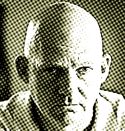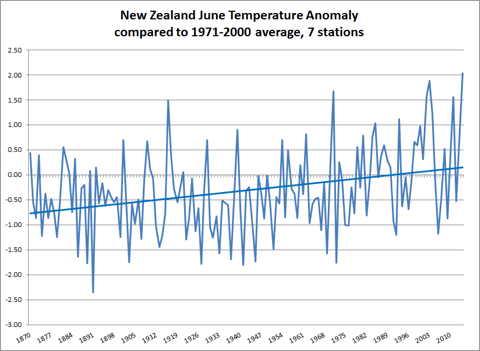 At The Daily Blog today I take a look at the latest report from the World Meteorological Organisation — The Atlas of Mortality and Economic Losses from Weather, Climate and Water Extremes 1970-2012 (pdf) — which demonstrates that major climate and weather disasters have increased fivefold since the 1970s. The implications are clear enough: damage from climate change is not something that will happen in the future — it’s here now, and we need to plan to be resilient to all the dislocation it will bring. Emissions cuts are important, but so is investing in policies that will help us to ride out the storm.
At The Daily Blog today I take a look at the latest report from the World Meteorological Organisation — The Atlas of Mortality and Economic Losses from Weather, Climate and Water Extremes 1970-2012 (pdf) — which demonstrates that major climate and weather disasters have increased fivefold since the 1970s. The implications are clear enough: damage from climate change is not something that will happen in the future — it’s here now, and we need to plan to be resilient to all the dislocation it will bring. Emissions cuts are important, but so is investing in policies that will help us to ride out the storm.
Author: Gareth
Little Whyte Bull
 Late last week, New Zealand’s far right ACT party was pleased to let the media know that its leader, Jamie Whyte, had won the “prestigious Institute of Economic Affairs’ Seldon ((Not this Seldon, sadly.)) Award” — an award given to IEA fellows by the IEA for work published by the IEA. Whyte is an IEA fellow, which may (or may not) be prestigious in itself — the IEA is the grandaddy of British free-market “think tanks” — but the award appears to be little more than a bit of mutual backslapping. Whyte won for a paper published last year entitled Quack Policy – Abusing Science in the Cause of Paternalism (pdf), in which he sets out to show that “much ‘evidence-based policy’ is grounded on poor scientific reasoning and even worse economics”. Unfortunately, in his discussion of climate science in the paper, he shows an incredibly poor understanding of what the science actually says, and an even worse appreciation of its implications for humanity.
Late last week, New Zealand’s far right ACT party was pleased to let the media know that its leader, Jamie Whyte, had won the “prestigious Institute of Economic Affairs’ Seldon ((Not this Seldon, sadly.)) Award” — an award given to IEA fellows by the IEA for work published by the IEA. Whyte is an IEA fellow, which may (or may not) be prestigious in itself — the IEA is the grandaddy of British free-market “think tanks” — but the award appears to be little more than a bit of mutual backslapping. Whyte won for a paper published last year entitled Quack Policy – Abusing Science in the Cause of Paternalism (pdf), in which he sets out to show that “much ‘evidence-based policy’ is grounded on poor scientific reasoning and even worse economics”. Unfortunately, in his discussion of climate science in the paper, he shows an incredibly poor understanding of what the science actually says, and an even worse appreciation of its implications for humanity.
TDB Today: Getting out the climate vote
 In this week’s article at The Daily Blog — Getting Out The Climate Vote — I take a look at the first batch of responses to the Climate Voter question of the week: President Obama calls climate change one of the most significant challenges we face, requiring urgent action by all governments. Do you agree?. No prizes for guessing who laughs in the face of civilisational suicide…
In this week’s article at The Daily Blog — Getting Out The Climate Vote — I take a look at the first batch of responses to the Climate Voter question of the week: President Obama calls climate change one of the most significant challenges we face, requiring urgent action by all governments. Do you agree?. No prizes for guessing who laughs in the face of civilisational suicide…
Record winter warmth in NZ: June 2014 breaks 140 year record

Hot off the press — or to be precise, Jim Salinger’s laptop: June 2014 was the warmest June in New Zealand since 1870, 2ºC above the 1971-2000 average, as measured by the long term “seven stations series” originally devised by Salinger and maintained by NIWA. On the larger 24 station series the month tied with 2003 at 2.1ºC above the 1971-2000 average. Many stations recorded warmest ever Junes, including Dunedin with 8.7ºC, +1.7°C above average, Invercargill with 7.8ºC (+2.2°C), Kaitaia (14.5, +1.7), Tauranga Aero (13.1, +2.4), Masterton Aero (9.8, +2.3), and Hokitika Aero (+10.4, +2.4). Jim points out that NZ warming is most clearly seen in the winter months (and expressed in the snow and ice record) but often escapes notice because a warm winter month is still “cool” compared with the seasons around it.
[Update 3/7: The Australian Bureau of Meteorology reports that the 12 months ending in June were the warmest July/June since records began (The Age. Jim Salinger tells me that in New Zealand July 13 to June 14 was the 3rd warmest in the long term record.]
Thin Ice: what polar science is telling us about climate
[vimeo 55642398 w=480]
This guest post is by professor Peter Barrett, executive producer, and Suze Keith, marketing advisor for Thin Ice.
Scientists can tell human stories about climate change, and a group of us have been working on just that for the last few years. We’ve produced a film — Thin Ice – the inside story of climate change — which follows a scientist, geologist and camera buff Simon Lamb, who is concerned at the flak his climate science colleagues have been taking.
Simon travels from the Antarctic to the Arctic. He listens to scientists talk about their work, hopes and fears, and discovers how the astonishing range of research really does fit together. By the end there are just two messages – that our ultimate goal should be zero carbon emissions (in line with the latest IPCC report), and that science really does work. As paleoclimatologist Dave Harwood says to young people at the end of the film:
Don’t be scared by this thing. Come and join in our effort. Be the best scientists and engineers you can, and we’ll deal with it.
Continue reading “Thin Ice: what polar science is telling us about climate”
